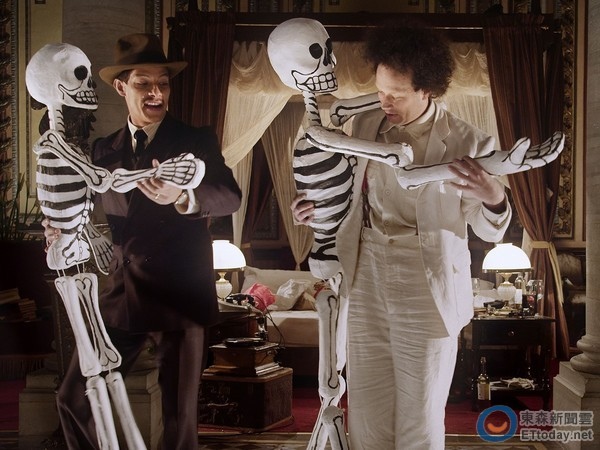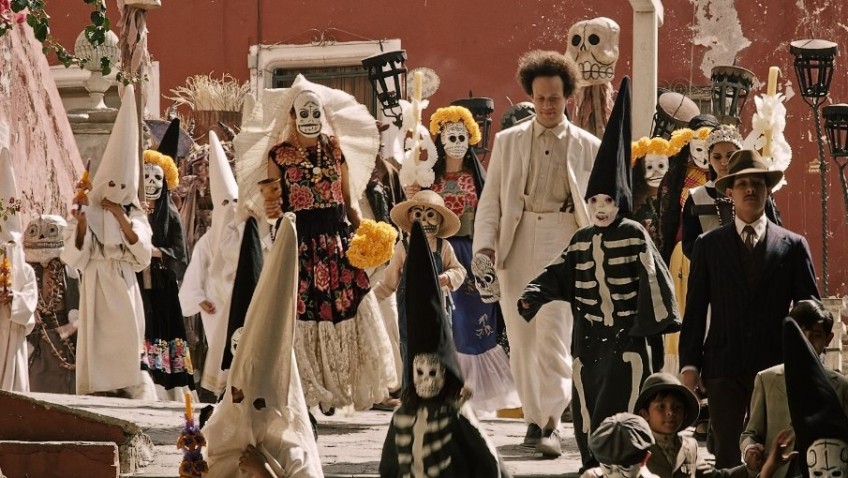Joyce Glasser reviews Eisenstein in Guanajuato
Recently, 70-year-old Peter Greenaway, a trained painter, has been luring his audience into the cinema with intellectually challenging and fascinating angles on artists known to us from art museums, history books and tourism. In Nightwatching, Rembrandt spends more time making love with the three women in his household than he does creating the mysterious masterpiece, Nightwatch. In the second of his ‘Dutch Master’ series, Goltzius and the Pelican Company, the 16th century Dutch engraver of erotic prints Hendrik Goltzius spends most of the film staging live, demonstrations of his pornographic Old Testament stories for a potential financier.
This week, Greenaway gives us something of a tour de force in his take on a little known interlude in Russian filmmaker Sergei Eisenstein’s life: his trip to Guanajuato, Mexico in 1931 to make a film about Mexico. Eisenstein in Guanajuato is more accessible and entertaining than the previous two biographical films, feeding digestible substance, in the form of famous real life characters, direct quotes and echoes of his cinematographic techniques, to a hungry audience. But Greenaway reduces the great director, to a clown who mocks and dances semi-naked around his concerned financier, Mrs Upton Sinclair. We see more of Finnish actor Elmer Bäck’s naked body than of Guanajuato or the aborted film his character was making.
 Eisenstein, at the height of his fame, travelled to Guanajuato after failing to secure a deal with the Hollywood studios. The famous American writer and communist sympathiser Upton Sinclair and his wealthy equestrian wife Mary Craig (Lisa Owen) negotiated a deal with Eisenstein for him to make a film about Mexican culture, provisionally called Que Viva Mexico. He was accompanied to Guanajuato by his regular cinematographer Eduard Tisse (Jakob Ohrman) and actor/co-director/writer Grisha Alexandrov (Rasmus Slätis)
Eisenstein, at the height of his fame, travelled to Guanajuato after failing to secure a deal with the Hollywood studios. The famous American writer and communist sympathiser Upton Sinclair and his wealthy equestrian wife Mary Craig (Lisa Owen) negotiated a deal with Eisenstein for him to make a film about Mexican culture, provisionally called Que Viva Mexico. He was accompanied to Guanajuato by his regular cinematographer Eduard Tisse (Jakob Ohrman) and actor/co-director/writer Grisha Alexandrov (Rasmus Slätis)
Native of Guanajuato and muralist Diego Rivera, who was a favourite of the American (and European) bohemian intelligentsia who flocked to Mexico in the 1920s and 1930s, and his wife, the painter Frieda Kahlo, were Eisenstein’s advisers. We see them greeting Eisenstein upon his arrival, but they quickly fade into the background. Not so Eisenstein’s guide, Palomino Cañedo (Luis Alberti), a scholar of comparative religion, family man and – who would suspect – a bi-sexual lothario. When Cañedo learns that Eisenstein is a virgin, he decides that his brief (no pun intended) should expand from a tour of the city to one of the filmmaker’s bed.
Greenaway apparently has history on his side and a legitimate licence to focus on Eisenstein’s sexual awakening. Eisenstein arrives in Guanajuato on 21st October; the anniversary of the Petrograd insurrection of 1917 was the 25th of October; and on 31st October, Mexico celebrates the Day of the Dead. According to Greenaway, these dates circumscribed Eisenstein’s love affair with Cañedo. Echoing the famous ’ten days that shook the world’, this affair led Eisenstein to say, ‘These are the ten days that shook Eisenstein. I had to come to Mexico to go to Heaven.’
The problem remains that however important the sex act is to the character, it is not very interesting, or enlightening, for the average cinema audience to watch. There may be people who find the very explicit sex stimulating, but it is safe to say it does not do much to advance the story or even enhance our understanding of Eisenstein.
So much of the film is focused on the sex that we begin to imagine that this dalliance had something to do with the film going over schedule, budget and with Eisenstein overstaying his visa.
According to Greenaway, Eisenstein became caught up by the historic city’s ties between Eros and Thanatos, sex and death. The spectre of Thanatos is represented by a cemetery-turned museum that contains naturally mummified bodies and the Day of the Dead festivities. We see the two lovers dancing with the life sized skeletons used in the festivities. The impact of Eros is represented by Eisenstein’s sexual awakening at age 33, which, Greenaway maintains, had an overwhelming impact on Eisenstein’s exceptional brain. Greenaway’s mind is nothing if not obsessively associative and Greenaway attaches great significance to the age of 33 – the age at which both Alexander and Christ died. He searched the globe for an actor who was 33, who looked like Eisenstein, and could approximate a Russian accent. With the possible exception of the accent, Finnish actor Elmer Bäck fit the brief, particularly in his Eisenstein hairdo.
What is special about Eisenstein in Guanajuato is the way in which Greenaway, and his editor Elmer Leupen, pay tribute to the footage that Eisenstein never saw let alone edited. We are hit with all of the editing vocabulary that might have enhanced film, from split screens, jump shots, close-ups contrasted with wide shots, archive footage, continual changes of pace and cinematographer Reinier van Brummelen’s still photos juxtaposed with his moving images. There are cinematic quotes in the images as well as in the dialogue, with cinematic cross references to Eisenstein’s cinematographer Eduard Tisse and contemporary photographers.
As you would expect from Greenaway, the sets, production design and lighting are beautiful and highly stylised. The actors are suitably exuberant and the non-expository incorporation of biographical detail in the film is admirable. The problem is not only with the extensive graphic sex, however, but with the contention that the director’s sexual awakening was significant because it influenced Eisenstein’s later films. This is quite a fascinating thesis, but one that the film does not address. It is known that Eisenstein, who travelled to Japan, said that the Japanese character writing he had learnt influenced his filmmaking style. You can’t help thinking that if Greenaway were to make a film about that trip to Japan we might see Eisenstein breaking his cherry under the cherry trees.




